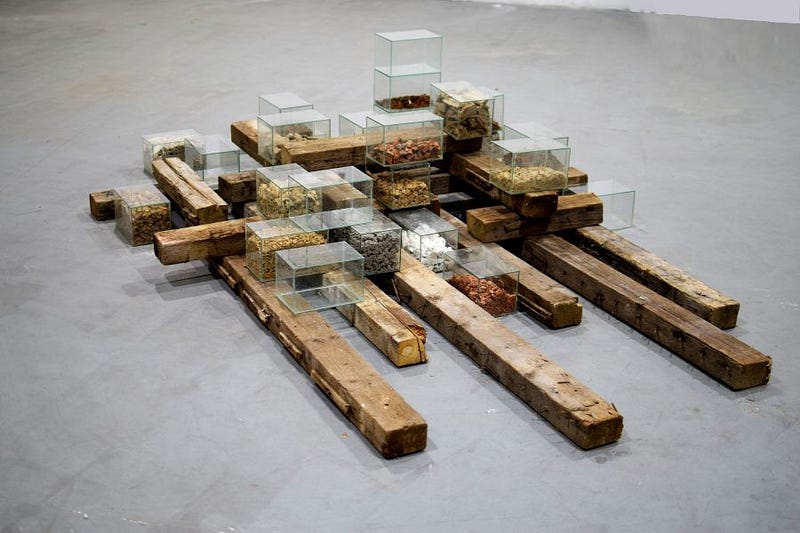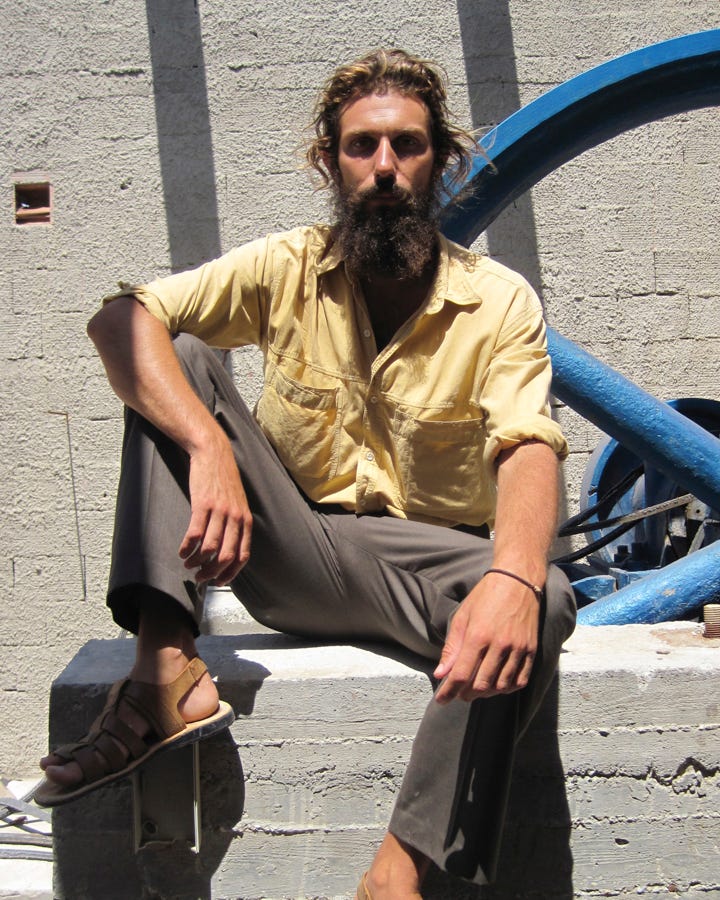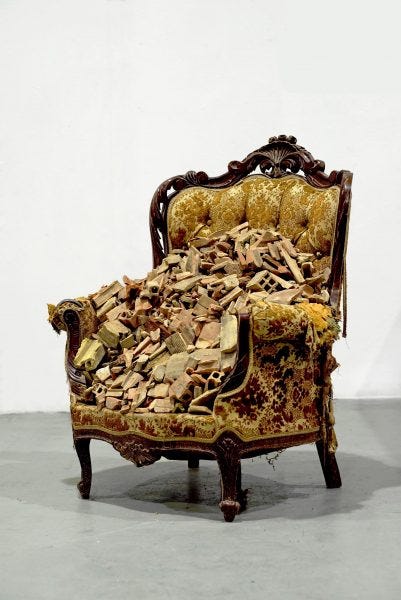21.10.2019
Shaping the Past as Our Own, with Help from Giorgos Palamaris
Visual arts

On the Cycladic island of Paros, Giorgos Palamaris tells me, there is a historic Byzantine church. At first glance, the structure appears unremarkable — but he believes that in this humble building, we can have a telling glimpse of Greek history.
He begins by describing how the church was constructed: an assemblage from a wide variety of material and architectural styles, a living cross-section that spans thousands of years. At its base, the foundations of earlier structures can be dimly made out, hinting at other, now-lost functions. On the surface, humble stone and wood mix with marble recycled from ancient temples, the past lending its weight to contemporary forms. As a professionally trained marble sculptor, as well as a frequent aide on archaeological sites (and even, an occasional house builder), Giorgos has a perceptive eye for such details of the built environment.
But for Giorgos, the real interest lies not in the church itself but for how this single place speaks to a much larger issue. Namely, how Greece needs to embrace its underlying reality as a chaotic mix of influences, peoples, languages, and periods. He goes on, “The Greeks have built so much of their identity on a glorious, and highly limited, view of the past: white marble here, Byzantine icons there, the modern state over there. We mustn’t clean up our history and purify it. It’s both racist and inaccurate. We have too often scrubbed away our ambiguities and preferred to force things into neat grids, like carefully laid-out archaeological sites.”
Slowly, Giorgos believes, archaeology has begun to adopt a different vision than the one it held in the past. After years of frustration with the discipline’s insistence on clear-cut divisions, he sees it demonstrating an interest in more ambiguous conclusions. But regardless of this shift, Giorgos is not confined to the field. Archaeological sites have offered Giorgos much more than a job: they have been formative to his art and his life, and allowed him to spend the past several years traveling between the islands of Delos and Despotiko. But ultimately, his identity lies elsewhere. He tells me, “This is why I feel so lucky to be an artist — to be able to look in a more open manner. I can take inspiration and poetic feeling from what I experience, and not feel the need to adhere to strict boundaries or scientific delineations.”
In his work as an artist, Giorgos wants to further blur these lines. While he strongly believes that we must be close to our past and live within it, he rejects a frozen glorification. Rather, through his work, he aims to create a dynamic relationship between past and present, to cultivate a thoughtful, ethical respect for history that also gives space to people living today. He summarizes, “We each have to learn how to make the past our own and find our own way to co-exist with it. Greece, with its rich heritage, has an opportunity to show the world how this can be done. Here, we have a flexibility and an openness to improvisation that many find maddening. But maybe these qualities can be used to help us reimagine old truths in new ways.”
Giorgos grew up in Pallini, a suburb of Athens. His father and grandfather had always worked with their hands, as builders, and thus Giorgos grew up as a child of construction, amidst the smell of churning cement and building materials. The family trade was no accident — the extended Palamaris clan hail from Tinos, one of a number of clustered Cycladic islands famous for their marble quarries and craftsmen. At the age of 19, Giorgos felt the desire to get closer to his roots and so he abandoned the city of Patras, where he had begun his studies, and moved to Tinos. There, he began his artistic training in the island’s School of Fine Art, which specializes in marble. He learned all the technical skills he would need to work with the material, to become a professional sculptor. But at the end of these studies, he felt the need to keep going.
The following year, he won a scholarship to study at the Fine Art School in Athens. The school pushed Giorgos to engage with sculpture as more than a craft, but as a multi-dimensional means of expression. He also began experimenting with installations, stage design, and a wide range of materials. Even more importantly, in Athens, Giorgos found a creative community. For five years, he shared a small studio space with three other friends. Their collaborations and their discussions further opened his eyes. The group offered Giorgos visual, intellectual, professional stimulation. He told me, “My friends have been my biggest inspiration; exchange with them my greatest teacher.”

Within this encouraging environment, Giorgos found himself at a crossroads. Growing up, he had never been interested in the way history was taught in schools. At the same time, he found himself continuously attracted to working with ruins and old objects. But the relationship between the two remained ambivalent. He recalls, with a smile, how he often used to think to himself when he was younger, “The center of Athens is so boring: why don’t they destroy the Acropolis and build something new there?”
Over the course of his time in art school, he steadily began to appreciate more the importance of culture. History, and then art history specifically, became his magnetic pole. He realized that his connection to the past came not from textbooks and ideas but from space and the material themselves. And so, in need of a way to support himself, Giorgos began working on archaeological sites. With this, a new world opened up: he felt like he was having a magical experience with the ancients. But he particularly marveled at how the past co-mingled with the present. He told me, “I can clearly remember a moment when I was working in Despotiko, reconstructing an archaic temple. I was having a break, making an Italian blend coffee on the box of a Chinese generator, between plastic bags full of fragments from the Geometric period. This overlaying of chronologies and cultures electrified me. Whereas an archaeological purist might resent this intermingling, as an artist, I was filled with wonder.”
From this story, we can clearly make out Giorgos’ philosophy when it comes to the past: open, vital, and alive. To further his point, he tells me about a site he worked on in Antiparos. There, a local shepherd had built a manger for his herd on top of what remained of an ancient temple to Apollo. Once the archaeologists came in, they fenced off the area entirely, making it inaccessible to the public. Of course, Giorgos recognized that heritage has to be protected and can’t just be used willy-nilly for livestock. On the other hand, overprotection results in making history even more remote, untouchable, and disconnected from our lives. As Giorgos says, “The essence of the problem is that of complete enclosure. Instead, we need to create a bond between ourselves and the past. By creating such airtight separations, this relationship never forms. In Greece, there are some ancient sites that are totally fenced-off from the public — but then are not well upkept. This is the worst. Because these sites are invisible to us, they are left to further ruin.”
What, I asked him, was an example of a more successful balance between preserving the past and meeting the needs of the present? When not staffed on archaeological projects, Palamaris also works periodically with a company that repairs and restores historic houses. The firm is committed to working on a slow, human scale. They avoid discarding material and do everything they can to find ways to give the existing structures new life. They aim to preserve the past not just for its own sake, but to provide a livable home for the current owners. A philosophy perfectly in line with how Giorgos wants to work with the past, in the present.
As another example, take the sculpture Giorgos made for the ARTWORKS exhibition, Mr. Ruin (Waiting for Hestia). When I first saw the work, it looked to me like nothing more than an unloved pile of rubble on a faded armchair. After talking to Giorgos, the sculpture became the perfect expression of his view on how we can relate to the past more ethically. The discarded material came from derelict interwar houses scattered around Athens — a cityscape long blighted by disused, abandoned structures, but which tragically are some of its most beautiful buildings. Though Giorgos can’t restore each of these houses himself, his artwork places this overlooked rubble in a venue for greater appreciation, giving it another life. It pushes us to reconsider how we move through the city and what could be done to bring its past and present into greater harmony. The fact that Giorgos carries out such work both on archaeological sites and people’s homes in parallel with his art practice is a testament to how deeply this belief guides him.
Mr. Ruin reveals one other important tenet of Giorgos’ perspective: his desire to make the art world more down to earth. With his broad smile, shoulder-length hair, and brimming beard, Giorgos brings something refreshingly humble to the too-often rarefied and disconnected world of contemporary art. Much as history must avoid becoming too separate from our current reality, art faces the same danger. Giorgos, in his work and his way of life, embodies ways to bridge such gaps.

To close, he tells me a story about the day the art-moving company came to transport his sculpture to the Niarchos Foundation in time for the ARTWORKS exhibition. When they came into his studio and saw the pile of rubble sitting on a chair, they told him there was no point in moving this pile of junk — couldn’t he just find some rubble closer to the exhibition space and haul it over himself? At first he joined in their laughter, but he also saw an opportunity. Convincing someone to engage with your ideas in a cultural institution is easy; reaching the wider public is where the real work begins. He explained to them what his sculpture meant and how he had gathered it. The movers grew interested; as their attention sharpened, the old tiles and cracked bricks were no longer being passed over and ignored. Bit by bit, thanks to Giorgos’ loving hand and infectious passion, they began to see things from his perspective, with newly appreciative eyes.
Alexander Strecker is pursuing a PhD in Art, Art History and Visual Studies at Duke University. His research explores how artistic practices register the contradictions inherent in ideas of crisis, periphery, and technology, with a focus on how these tensions are felt acutely in contemporary Greece while also resonating worldwide.



